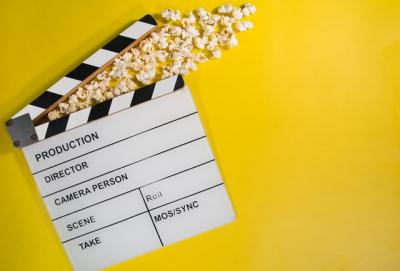Top 10 films featuring research software
Posted on 6 October 2020
Top 10 films featuring research software
 Photo by GR Stocks on Unsplash
Photo by GR Stocks on Unsplash
By Director Neil Chue Hong.
This post is part of our 10 year anniversary series.
As well as working with research software, I’m also a big film fan. So what better way to celebrate the 10th anniversary of the SSI than to share my top ten examples of software in the movies!
When researching this post, I wanted to highlight the more realistic uses of software on screen - it’s all too easy to find a film where another Artificial Intelligence goes rogue or the many woeful attempts to show cybercrime (so no Swordfish, even though it takes its name from one of the most famous passwords featured in a film).
1. Destination Moon (1950)
One of the first examples of a computer being used to do research in a fillm came in Destination Moon, where a General Electric differential analyzer (a type of analogue computer which used a wheel-and-disc mechanism as the “software”) was used to calculate the trajectory of the moon rocket. Spoiler: it also predicts the role of private tech billionaires in driving forward computer innovation.
2. 2001 (1968)
Stanley Kubrick’s epic film taking in humanity’s quest for knowledge is famous for its accurate depiction of space travel and yet another AI gone rogue. However, what it gets across better than any other film is the sheer banality of many large scientific experiments and how, even once we’ve solved super long-distance communication, we still need to reinstall the firmware on our equipment to get them to work properly.
3. Wargames (1983)
Who doesn’t love a good game of “Global Thermonuclear War”? Matthew Broderick would go on to play a nuclear radiation researcher in the remake of Godzilla, so this was just practice for the role. A great example of how computer simulation is useful in many situations, and the requirement to airgap your more important systems.
4. Real Genius (1985)
Val Kilmer is an ace undergraduate physics student… no wait, bear with me… part of a crack laser physics research team and a party animal. Despite the somewhat odd premise, this film heralds the rise of the personal computer, featuring various Apple and HP computers being used to control laser experiments, reprogram guidance systems and solving power problems. This ain’t no Weird Science.
5. Jurassic Park (1993)
Back in the early 90s, Jurassic Park was amazing cinemagoers with a combination of computer-generated and animatronic effects to make you believe that dinosaurs return. However, it also features two great examples of software: in one of the first scenes a ground-penetrating radar gun is hooked up to some pretty experimental computer equipment to process the signals, showing the value of proper research technicians; and near the end, not only is Lex Murphy a UNIX geek, she gets to explore the park’s filesystem using “fusion” (fsn), a 3D file system navigator made by SGI for IRIX systems.
6. Twister (1996)
Inspired by the work of NOAA’s Severe Storms Laboratory, much of the scientific equipment in Twister is based on real-life technology. A specially built SGI Indy laptop is used to capture the data from all the sensors that Dorothy (tornado research device) releases into the heart of the twister, and visualise the vortex.
7. Minority Report (2002)
Always someone interested in the future of research, Steven Spielberg convened a panel of 15 experts to create a plausible future reality for the setting of Minority Report. Not only did it offer a scarily prescient view of what happens when you use algorithms to make decisions, it also created the gesture-based, multi-touch technology that would later be implemented in the Microsoft PixelSense (and used to great effect in the reboot of Hawaii Five-0).
8. Moneyball (2011)
Okay, so you don’t actually see the software on-screen that much in Moneyball, but it’s effectively the main supporting character in this film about how sabermetrics - the use of statistical analysis in baseball - revolutionised the way the sport was played by identifying the most cost-effective way to build a team. Hope they used Pandas or R rather than Excel!
9. Arrival (2016)
Arrival is a beautiful film in many ways, but none more so than for making a linguist the hero. One of the most breathtaking pieces of imagery is the alien language - a series of fluid logograms which look a bit like coffee stains. Amy Adams' character, Louise Banks spends late nights in front of her laptop trying to decipher them using Mathematica - a very subtle form of product placement as its inventor, Stephen Wolfram, was a consultant on the film. The iterative approach she takes is very reminiscent of an actual research workflow, and this is one of the more “realistic” depictions of what happens when researchers are asked to help make first contact.
10. Hidden Figures (2016)
We started with spaceflight and we end with spaceflight. Hidden Figures is the story of the black female mathematicians who worked at NASA during the Space Race. As human computers, their job was to check the results coming out of the IBM 7090 mainframe, learn to program in FORTRAN and send humans into space safely. It’s also a timely reminder that researchers of all genders and nationalities have been involved in research software from the very start. And, even though we have Kerbal Space Program to let us all calculate trajectories and orbits from the comfort of our own homes, this film reminds us that it’s always good to test our code!

